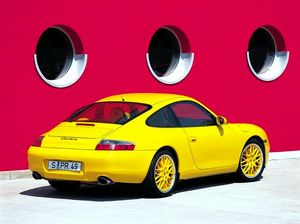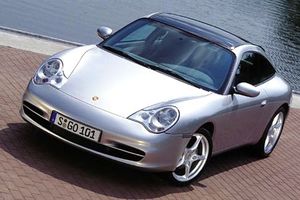.
Porsche 996: Difference between revisions
No edit summary |
No edit summary |
||
| Line 70: | Line 70: | ||
The standard Carrera models were joined in 2000 by a Carrera-based 'Millenium' model, finished in Vesuvius Metallic with chromed 'Turbo Technic' alloys. Only 911 were built worldwide. In 2002, the whole range was updated, featuring new bumpers, alloy wheels, front lights, colour charts and equipment levels. The power went up slightly, as the bored-out 3.6 litre engine made its debut. To celebrate 40 Years of 911, in 2004 a special Celebration model was produced - again with a production run of only 911 units worldwide - and featured the Aerokit as standard, the GT Silver paint from the Carrera GT, and boosted interior specifications. This model was the only 911 since the 1980s to actually be badged so - a special rear badge was designed, which was essentially '911' in an italicised script. | The standard Carrera models were joined in 2000 by a Carrera-based 'Millenium' model, finished in Vesuvius Metallic with chromed 'Turbo Technic' alloys. Only 911 were built worldwide. In 2002, the whole range was updated, featuring new bumpers, alloy wheels, front lights, colour charts and equipment levels. The power went up slightly, as the bored-out 3.6 litre engine made its debut. To celebrate 40 Years of 911, in 2004 a special Celebration model was produced - again with a production run of only 911 units worldwide - and featured the Aerokit as standard, the GT Silver paint from the Carrera GT, and boosted interior specifications. This model was the only 911 since the 1980s to actually be badged so - a special rear badge was designed, which was essentially '911' in an italicised script. | ||
In conjunction with the 2002 revamp, the Targa model was unveiled - and was essentially a Carrera or Carrera 4 with the sliding glass roof as premiered on the 993 model almost a decade earlier. The new car was designed with a rear hatch window, making it the most practical sports car on the market. Again, the Targa was engineered by using a Cabriolet bodyshell as a base, then adding strong visual bars to top off the doors. From a side profile, the Targa has a sharper angle to the rear window over the standard Coupe. | [[image:Porsche_996_Targa.jpg|thumb]] In conjunction with the 2002 revamp, the Targa model was unveiled - and was essentially a Carrera or Carrera 4 with the sliding glass roof as premiered on the 993 model almost a decade earlier. The new car was designed with a rear hatch window, making it the most practical sports car on the market. Again, the Targa was engineered by using a Cabriolet bodyshell as a base, then adding strong visual bars to top off the doors. From a side profile, the Targa has a sharper angle to the rear window over the standard Coupe. | ||
==Moving Upwards - the Super-996s== | ==Moving Upwards - the Super-996s== | ||
Revision as of 17:16, 1 February 2007

| |
| Porsche 996 | |
|---|---|
| Porsche | |
| aka | Porsche 911 Carrera |
| Production | 1996-2005 |
| Class | Sports Luxury |
| Body Style | Coupe/Cabriolet/Targa |
| Length | |
| Width | |
| Height | |
| Wheelbase | |
| Weight | |
| Transmission | 6-speed manual 5-speed Tiptronic |
| Engine | 3.4 litre flat six 3.6 litre flat six 3.6 litre flat six, turbocharged |
| Power | 300 BHP 450 BHP (Turbo) |
| Similar | Ferrari 360 Modena Aston Martin V8 Vantage Mercedes-Benz SL500 |
| Designer | Pinky Lai |
Task: To Perfect Perfection
The 996 model was given an un-enviable task - to replace the legendary, and very popular, 993 model, and also to carry the Porsche company into record profits and the new Millenium. The new model was redesigned from the ground-up from its predecessors, and featured a new chassis, transmission, engine and bodywork. The engine had decreased in capacity, to 3.4 litres, and was water-cooled, for the first time in a Porsche flat-six. Porsche cited ever-stringent emission and noise regulations for the swap in cooling - but Porsche enthusiasts moaned that the distinctive sound would be lost. But they hadn't heard it yet.
The engine was not the only point for criticism for the new 996, however. The general press and public pointed out that the front end was identical to its smaller sibling - the Boxster, a car almost half the price of the 911. But Porsche was eager to get people to see behind these 'faults', and embrace the radically different but comfortably similar new incarnation of the world's most famous sportscar.
Ground-up Re-engineering
The 993 could never be described as ageing, but its Achilles' heel was the power plant, which was rooted in the past, and although Porsche had bought the engine some time from the strict worldwide emissions regulations and drive-by noise limitations with the excellent VarioCam system, the writing was on the wall, and the decision was taken to produce a whole new 911 which could conceivably carry the company well into the 2000s - and for this to happen, a new engine had to be built.
The flat-six Boxer configuration was retained, and air-cooling was scrapped, to make way for the water-cooling system, which was both more efficient and crucially, quieter. Capacity shrunk 200 cubic centimetres to 3.4 litres, but power was up overall to 300 BHP. But the engine was only part of the story.
The exterior design was penned by Pinky Lai, and was refreshingly contemporary over the 993. The front lights and driving lights of the 993 were incorporated into one pod, christened the 'Fried Egg' by its detractors. The evocative roofline remained, and the rear lost the reflector stripe under the bonnet - which was now lined by two larger units, incorporating all the necessary accoutrements. The doorhandles were now flush to the bodywork, and the doors were rimless, and to complement the changes, a whole new range of alloy wheels were designed, proving to be evolutions of their 993 predecessors.
The radical developments continued indoors. The traditional 'five dial' dash was ditched, and replaced with a more modern, smoother dashboard. The seat design was revised, and the cabin as a whole was larger and better equipped - a whole host of new electrical toys were made available for the 996 that space permitted in the 993. A new colour chart and interior material list was drawn up, and the 996 featured leather seats as standard.
Under the skin, the power was delivered to the road by the now-traditional Carrera two wheel-drive and Carrera 4 four wheel-drive platforms, intercepted by a six-speed manual or revised five-speed Tiptronic semi-automatic gearbox.
The standard Carrera models were joined in 2000 by a Carrera-based 'Millenium' model, finished in Vesuvius Metallic with chromed 'Turbo Technic' alloys. Only 911 were built worldwide. In 2002, the whole range was updated, featuring new bumpers, alloy wheels, front lights, colour charts and equipment levels. The power went up slightly, as the bored-out 3.6 litre engine made its debut. To celebrate 40 Years of 911, in 2004 a special Celebration model was produced - again with a production run of only 911 units worldwide - and featured the Aerokit as standard, the GT Silver paint from the Carrera GT, and boosted interior specifications. This model was the only 911 since the 1980s to actually be badged so - a special rear badge was designed, which was essentially '911' in an italicised script.
In conjunction with the 2002 revamp, the Targa model was unveiled - and was essentially a Carrera or Carrera 4 with the sliding glass roof as premiered on the 993 model almost a decade earlier. The new car was designed with a rear hatch window, making it the most practical sports car on the market. Again, the Targa was engineered by using a Cabriolet bodyshell as a base, then adding strong visual bars to top off the doors. From a side profile, the Targa has a sharper angle to the rear window over the standard Coupe.
Moving Upwards - the Super-996s
The Turbo
The obligatory Turbo model raced onto the price lists in 1999, boasting headline-grabbing performance figures such as 420BHP - from a twin-KKK-turbocharged 3.6 litre - and a sub six second 0-60mph time. The Turbo lines transferred well to the 996 shape - but the general opinion was that the car had lost a little visual drama over the outgoing 993. The 'Tea Tray' spoiler, once the trademark of the Turbo model, was dead, replaced by an almost-ducktail speed-operated, electrically-lifting example. The once-expansively wide rear arches were not as pronounced, but the impressive alloy wheels were retained, albeit in a modernised form.
But Porsche let the chassis and powerplant forge an impression of the car, and period press struggled for enough superlatives to describe the other-worldly performance, exploitable chassis and almost-impossible-with-such-performance everyday usability. Porsche had certainly produced a stunning automobile with the 996 Turbo, and strong sales reflected this. Technology was a trademark of the model, with such aerodynamic wonders like the rear-bumper air vents - which created a vaccuum behing the car, sucking hot air from the engine. The carbon-composite brakes made their debut on the model - badged PCCB, and developed from Porsche's recent Le Mans activities, these amazing brakes promised fade-free performance. However, they carried a price tag to match - around £8,000!
The Turbo also filled the 'Luxury' part of its class tag. The interior was the first word in leather-lined opulence, with electric everything, and generous standard equipment levels.
Also available on the Turbo was the X50 option - the power kit. This harnessed better breathing and engine mapping to release and extra 80BHP, producing a peak 500BHP. Torque figures almost mirrored this. With the X50 option, the 996 Turbo was peerless in every respect.
From 2005, the Turbo S model was available, essentially as a run-out model. The car carried a price premium over the standard model, but featured the X50 option, Graphite-painted alloys, a special 'Olive Green' paint option and the Porsche Carbon Composite Brakes (PCCB) as standard. Equipment levels were high, and an LSD was also added to the standard specification sheet.
The GT3
The GT3, released in 1998, was essentially the Carrera RS-equivalent for the 996 generation. However, the GT3 was a much more advanced engineering proposition compared to the standard RS ethos of weight reduction and sports suspension.
See Also

